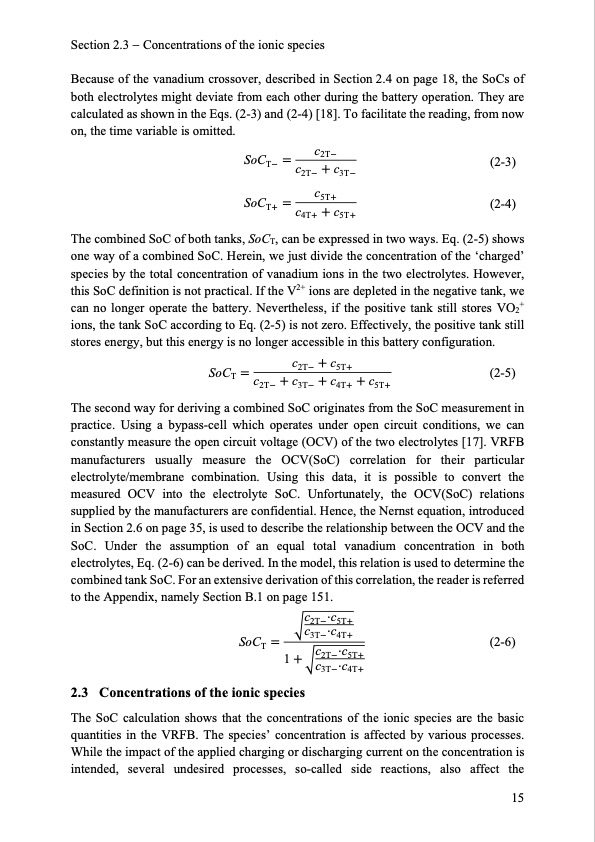
PDF Publication Title:
Text from PDF Page: 023
Section 2.3 Concentrations of the ionic species Because of the vanadium crossover, described in Section 2.4 on page 18, the SoCs of both electrolytes might deviate from each other during the battery operation. They are calculated as shown in the Eqs. (2-3) and (2-4) [18]. To facilitate the reading, from now on, the time variable is omitted. SoCT c2T (2-3) c2T c3T SoCT c5T (2-4) c4T c5T The combined SoC of both tanks, SoCT, can be expressed in two ways. Eq. (2-5) shows one way of a combined SoC. Herein, we just divide the concentration of the ‘charged’ species by the total concentration of vanadium ions in the two electrolytes. However, this SoC definition is not practical. If the V2+ ions are depleted in the negative tank, we can no longer operate the battery. Nevertheless, if the positive tank still stores VO2+ ions, the tank SoC according to Eq. (2-5) is not zero. Effectively, the positive tank still stores energy, but this energy is no longer accessible in this battery configuration. SoCT c2T c5T (2-5) c2T c3T c4T c5T The second way for deriving a combined SoC originates from the SoC measurement in practice. Using a bypass-cell which operates under open circuit conditions, we can constantly measure the open circuit voltage (OCV) of the two electrolytes [17]. VRFB manufacturers usually measure the OCV(SoC) correlation for their particular electrolyte/membrane combination. Using this data, it is possible to convert the measured OCV into the electrolyte SoC. Unfortunately, the OCV(SoC) relations supplied by the manufacturers are confidential. Hence, the Nernst equation, introduced in Section 2.6 on page 35, is used to describe the relationship between the OCV and the SoC. Under the assumption of an equal total vanadium concentration in both electrolytes, Eq. (2-6) can be derived. In the model, this relation is used to determine the combined tank SoC. For an extensive derivation of this correlation, the reader is referred to the Appendix, namely Section B.1 on page 151. c2T ⋅c5T .SoCT c3T⋅c4T (2-6) 1 c2T⋅c5T c3T ⋅c4T 2.3 Concentrations of the ionic species The SoC calculation shows that the concentrations of the ionic species are the basic quantities in the VRFB. The species’ concentration is affected by various processes. While the impact of the applied charging or discharging current on the concentration is intended, several undesired processes, so-called side reactions, also affect the 15PDF Image | Model-based Design Vanadium Redox Flow Batteries

PDF Search Title:
Model-based Design Vanadium Redox Flow BatteriesOriginal File Name Searched:
10-5445IR1000070670.pdfDIY PDF Search: Google It | Yahoo | Bing
Salgenx Redox Flow Battery Technology: Salt water flow battery technology with low cost and great energy density that can be used for power storage and thermal storage. Let us de-risk your production using our license. Our aqueous flow battery is less cost than Tesla Megapack and available faster. Redox flow battery. No membrane needed like with Vanadium, or Bromine. Salgenx flow battery
| CONTACT TEL: 608-238-6001 Email: greg@salgenx.com | RSS | AMP |